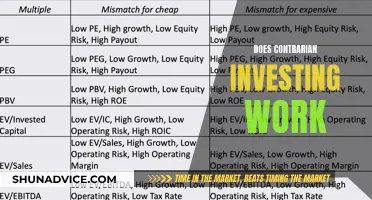
As you approach retirement, you may need to adjust your investment strategy to ensure your financial security. This involves a shift from accumulating assets to spending them, with less margin for error as investment mistakes can lead to significant losses. A key consideration is your portfolio withdrawal rate, which is the percentage of your investment accounts you need to withdraw each year to cover living expenses. It's recommended that this doesn't exceed 4% on average. The sequence of stock market returns around your retirement date will also impact your portfolio balance and spending ability, so it's important to assess your risk tolerance and adjust your investments accordingly. Generally, as you get closer to retirement, you should move from stocks to more stable, lower-earning funds like bonds and consider adding a fixed annuity to dampen the effects of market downturns.
| Characteristics | Values |
|---|---|
| Investment strategy | Gradually shift from stocks to bonds to protect accumulated wealth |
| Stock-bond ratio | 50-50 for 55-64 age group |
| Time horizon | Shorter time horizon = less risky investments |
| Risk tolerance | Older investors prefer more conservative investments |
| Asset allocation | Should be re-evaluated after significant life events |
| Tax strategies | Take advantage of tax-deferred accounts and catch-up contributions |
| Annuities | Can provide guaranteed income for life |
| Social Security | Delaying benefits after age 62 increases benefits |
What You'll Learn
- Gradually shift from stocks to bonds to protect accumulated wealth
- Maintain a healthy dose of stocks for potential long-term growth
- Consider a financial advisor to help determine an appropriate investment approach
- Understand your portfolio withdrawal rate and how this translates to risk
- Diversify your portfolio to mitigate the chance of a bad market environment derailing your plans

Gradually shift from stocks to bonds to protect accumulated wealth
As you approach retirement age, it is generally recommended to gradually shift from stocks to bonds to protect your accumulated wealth. This is because bonds are less volatile and considered a safer investment option. While stocks offer higher potential returns, they also come with higher risks. As individuals near retirement, they have less time to recover from potential losses, so shifting to safer options like bonds can help preserve their savings.
The recommended ratio of stocks to bonds in your investment portfolio gradually shifts as you age. For example, for individuals aged 25 to 34, a portfolio comprising 80% stocks and 20% bonds is suggested. This ratio changes to 70% stocks and 30% bonds for those aged 35 to 44, and 60% stocks and 40% bonds for individuals aged 45 to 54. As you get closer to retirement, a 50-50 split between stocks and bonds is often recommended for those aged 55 to 64.
Retirement can last for several decades, so it is still important to maintain a balanced portfolio with a healthy mix of stocks and bonds. Stocks can provide the potential for higher returns, while bonds offer more stability. This balance between growth and income is crucial when planning for a retirement that could span many years.
To simplify this process, consider "target-date retirement funds" offered by many retirement plans. These funds automatically adjust the mix of stocks, bonds, and cash based on your planned retirement year. They are designed to maximise your returns while minimising risk as you get older, without requiring you to actively manage your asset allocation.
It is important to remember that investment strategies should be tailored to your individual circumstances, risk tolerance, and financial goals. Consulting a financial advisor can help you make informed decisions about your investment portfolio as you approach retirement.
Successful People Invest in Themselves
You may want to see also

Maintain a healthy dose of stocks for potential long-term growth
As you approach retirement age, it is generally recommended to maintain a healthy balance of stocks as part of your investment portfolio to take advantage of their long-term growth potential. While it is important to reduce exposure to riskier investments, stocks typically offer higher returns than other asset classes and can help counterbalance inflation.
Stocks should remain an important part of your portfolio regardless of your age, as they provide the opportunity for your investments to grow over time. However, as you get closer to retirement, it is crucial to assess your risk tolerance and adjust your asset allocation accordingly. This means gradually reducing your allocation to riskier stocks and increasing your allocation to more conservative investments, such as bonds and cash equivalents.
For example, a recommended stock-bond ratio for individuals aged 55 to 64 is 50%-50%. This balance can help maximize returns while minimizing risk as you approach retirement. By contrast, younger investors aged 25 to 34 can allocate 80% of their portfolio to stocks and 20% to bonds, taking advantage of their longer investment horizon and higher risk tolerance.
It is also important to periodically rebalance your portfolio to maintain your desired asset allocation. This may involve selling some stocks and buying bonds or other assets to ensure your portfolio aligns with your risk profile and investment objectives.
In addition to stocks, consider diversifying your portfolio across different asset classes, such as bond funds, real estate, and commodities. This diversification can help protect your portfolio during market downturns and provide a more stable source of income during retirement.
While retirement often signifies a shift towards more conservative investments, maintaining a healthy dose of stocks can help maximize your investment returns and ensure your portfolio remains aligned with your long-term financial goals.
Oil Investment: Why the Appeal?
You may want to see also

Consider a financial advisor to help determine an appropriate investment approach
As you approach retirement, you may want to consider consulting a financial advisor to help determine an appropriate investment approach. A financial advisor can provide valuable insights and guidance based on your specific circumstances and goals. Here are some reasons why seeking professional advice can be beneficial:
- Expertise and Experience: Financial advisors are trained and experienced in investment strategies, risk management, and retirement planning. They can provide you with a comprehensive assessment of your financial situation and offer tailored advice.
- Risk Assessment and Management: Advisors can help you understand your risk tolerance and make informed decisions about your investment portfolio. They can guide you in balancing risk and return, especially as you transition from accumulating assets to spending them during retirement.
- Retirement Income Planning: Advisors can assist in developing a retirement income plan that considers your expected income sources, such as Social Security, pensions, and investment withdrawals. They can help you diversify your income streams and ensure a steady cash flow during retirement.
- Tax and Estate Planning: They can provide guidance on tax strategies, such as taking advantage of tax-deferred accounts and catch-up contributions. Additionally, they can help with estate planning, including wills, trusts, and beneficiary designations, ensuring that your assets are distributed according to your wishes.
- Market Volatility and Adjustments: Financial advisors monitor market trends and can help you navigate volatile markets. They can advise on when to make adjustments to your investment portfolio, such as shifting from stocks to bonds or exploring target-date retirement funds.
- Personalised Investment Strategies: A financial advisor takes the time to understand your unique circumstances, including your financial goals, risk tolerance, and time horizon. They can then develop a customised investment strategy that aligns with your needs and objectives, both before and during retirement.
Remember, retirement planning is a dynamic process, and your investment strategy may need to evolve over time. Seeking professional advice can help you make informed decisions and feel more confident about your financial future.
The Debt Dilemma: Cashing in Investments to Settle the Score
You may want to see also

Understand your portfolio withdrawal rate and how this translates to risk
Understanding your portfolio withdrawal rate and the associated risks is a crucial aspect of retirement planning. The safe withdrawal rate (SWR) method is a strategy that helps retirees determine how much they can spend from their retirement accounts annually without depleting their savings prematurely. This method is based on the assumption that retirees will want to maintain a steady income for their retirement duration, often estimated at 30 years.
The SWR is calculated as a percentage of the portfolio's balance at the time of retirement, typically ranging from 3% to 5%. For example, if you retire with $750,000 in your account, a 4% withdrawal rate would allow you to withdraw $30,000 in the first year. This rate is then adjusted for inflation in subsequent years. It's important to note that this calculation assumes no growth in your portfolio, and the longevity of your funds is inversely proportional to your withdrawal rate.
The popular 4% rule, also known as the safe withdrawal rate, is a guideline for retirees to ensure they don't run out of money. This rule suggests withdrawing no more than 4% of your starting balance each year, adjusted for inflation. While it doesn't guarantee that you won't deplete your funds, it helps protect your portfolio during market downturns by limiting withdrawals.
As you approach retirement, it's essential to consider adjusting your investment strategy to reduce risk. This often involves shifting from stocks to more stable, lower-risk investments like bonds and cash. The closer you are to retirement, the less time you have to recover from potential losses, so a more conservative approach may be advisable.
However, retirement can span several decades, and maintaining some stocks in your portfolio can provide growth opportunities. A balanced approach is recommended, and "target-date retirement funds" offered by many plans can automatically adjust your asset allocation to maximise returns and minimise risk as you age.
Lucrative Investment Opportunities: Exploring the Highest-Paying Ventures
You may want to see also

Diversify your portfolio to mitigate the chance of a bad market environment derailing your plans
Diversifying your portfolio is a crucial step in mitigating the risk of a bad market environment derailing your plans. Here are some strategies to achieve effective diversification:
Spread the Wealth
Diversification is not limited to stocks and bonds. Explore various asset classes such as commodities, exchange-traded funds (ETFs), and real estate investment trusts (REITs). Consider investing in a handful of companies across different sectors that you know and trust, even those you use in your daily life. This way, you spread your risk and increase your chances of bigger rewards.
Index and Bond Funds
Index funds and fixed-income funds are excellent additions to your portfolio. These funds track various indexes, aiming to match the performance of broad indexes like the bond market. By investing in these securities, you benefit from low fees and a wonderful long-term diversification strategy. However, keep in mind that index funds are passively managed, which might be suboptimal in inefficient markets.
Regularly Add to Your Portfolio
A strategy called dollar-cost averaging can help smooth out the peaks and valleys of market volatility. With this approach, you invest a fixed amount of money regularly into a specified portfolio of securities. As a result, you buy more shares when prices are low and fewer when prices are high, reducing your overall investment risk.
Know When to Exit
While buying and holding, and dollar-cost averaging are great strategies, staying informed about your investments and the overall market conditions is crucial. Keep an eye on the companies you invest in to recognise when it's time to cut your losses and move on to the next investment opportunity.
Be Mindful of Commissions
Understand the fees you are paying, especially if you are not an active trader. Some firms charge monthly fees, while others have transactional fees, which can quickly add up and eat into your profits. Today, many online brokers offer commission-free trading for stocks and ETFs, but mutual funds, illiquid stocks, and alternative asset classes often come with fees.
Avoid Over-Diversification
While diversification is essential, it is possible to over-diversify. Adding too many securities to your portfolio might dilute your returns. A portfolio with too many ETFs or mutual funds, for example, could lead to overlapping investments that do not provide additional diversification benefits. Keep your portfolio manageable, and ensure that each investment adds genuine diversification value.
By implementing these strategies, you can effectively diversify your portfolio to reduce the chances of a bad market environment derailing your retirement plans.
Theranos: Why Investors Bought the Lie
You may want to see also







